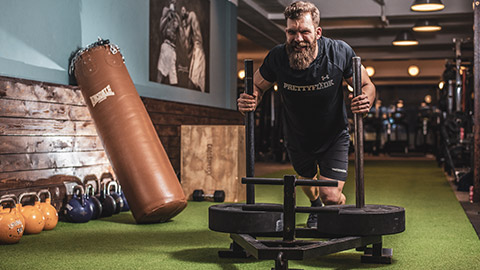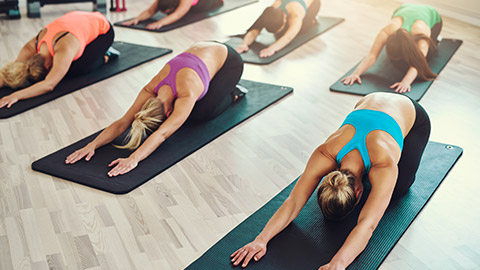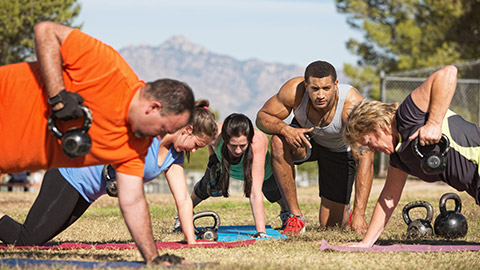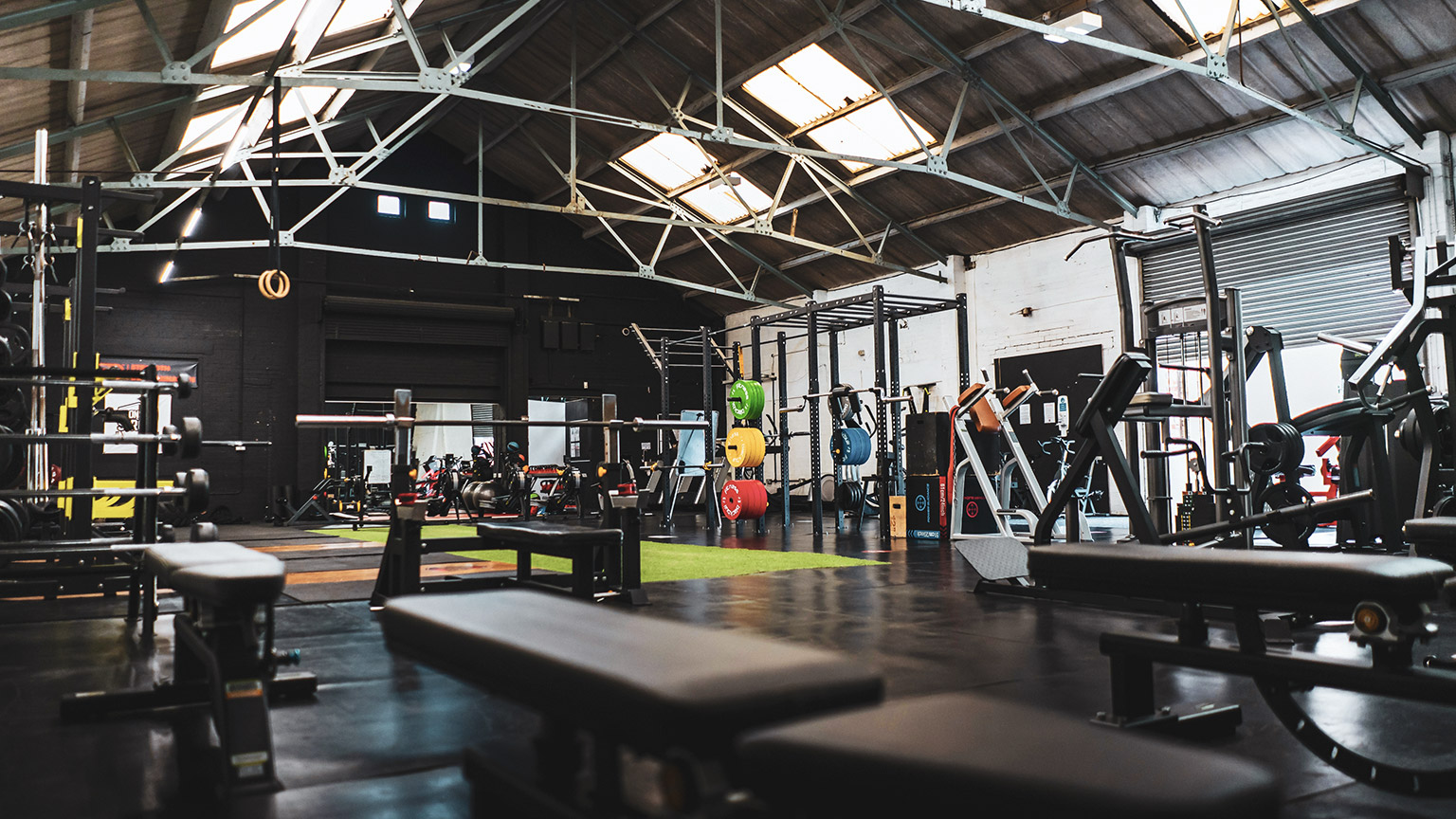This topic describes different facilities commonly found in the fitness industry and their impact on our professional practice. You will learn about a diverse range of facilities and how these facilities provide a variety of equipment, resources, and amenities to support fitness goals and enhance client experiences. Understanding these facilities will help you to tailor workout programmes, provide a safe training environment, offer diverse exercise options, and create a well-rounded fitness regimen for your clients.
The fitness industry has evolved a lot over the last few decades. The large commercial gym (like a Golds Gym) still has its place in the market, but it has been joined by many other fitness facilities such as:
- Personal training studios
- Budget, low-service gyms
- Functional, community-focused boxes
- Yoga studios
- Outdoor bootcamps
Let’s look at these in more detail.
Functional boxes

In the early 2000s, traditional gyms dominated the fitness landscape. People focused on cardio machines and isolated weight training. CrossFit, founded in 2000, challenged this status quo by introducing high-intensity functional workouts that combined weightlifting, gymnastics, and aerobic exercises. CrossFit boxes emerged as specialised spaces equipped with unique equipment and a strong community atmosphere. The CrossFit movement emphasised functional fitness, camaraderie, and competition, resonating with those seeking a more dynamic and social fitness experience.
Not long after this, other providers saw CrossFit's impact on the industry and jumped on its back, providing another type of functional HIIT training without being quite as advanced in terms of the prescribed movements. In 2012 F45 Training entered the scene. F45, which stands for "Functional 45," aimed to provide a results-oriented, group-based workout in a concise 45-minute session. These studios offered a variety of high-intensity interval training (HIIT) workouts that targeted cardiovascular fitness and strength. The concept appealed to time-conscious individuals seeking efficient and effective workouts, and F45 quickly expanded worldwide.
Orange Theory Fitness, founded in 2010, brought another innovative approach to the fitness industry. It focused on heart rate-based interval training, using technology to track and optimise workouts. Orange Theory's signature workouts aimed to boost calorie burning and endurance while incorporating elements of strength and power. Anaya, 2022. This data-driven approach attracted a segment of the population interested in quantifiable fitness metrics.
The evolution of fitness facilities like CrossFit boxes, F45, and Orange Theory reflects changing consumer preferences for more specialised, efficient, and community-driven workouts. There are many other similar facilities, such as 9 Rounds, BFT (bodyfit training), and independent gyms, such as the Hub 5010, in the same space.
Yoga studios

Yoga studios are dedicated spaces where individuals come together to practice yoga, a holistic discipline that blends physical postures, breath control, meditation, and ethical principles to promote physical, mental, and spiritual well-being.
Yoga traces back to ancient India, where yoga originated as a spiritual and meditative practice. Over the centuries, yoga has transformed into a global phenomenon with diverse styles, such as Hatha, Yin, Ashtanga, Vinyasa, and Bikram, each catering to different needs and preferences. There are even niche offerings such as sound bowl yoga or stand-up paddle board yoga that are gaining in popularity.
Modern yoga studios have adapted to meet the demands of contemporary urban lifestyles. They offer a tranquil escape from the hustle and bustle of daily life, providing a respite for individuals seeking balance, stress relief, and improved health. Some studios focus on traditional practices, while others incorporate elements of fitness, hot yoga, or mindfulness to cater to a broader demographic.
The popularity of yoga has steadily increased over the past decade as stress, busyness, and mental issues have risen. Yoga now attracts a lot of corporate clientelle who try to balance their stressful work lives with a form of exercise that helps them physically, mentally, emotionally, and sometimes spiritually.
Outdoor bootcamps

Outdoor fitness bootcamps have gained significant prominence in the fitness industry over the past two decades. These high-intensity group workouts typically take place in outdoor settings such as parks, beaches, or fields and generally work on the HIIT modality, which was covered in depth in Module 4. Sessions usually involve combination of strength training, cardio exercises, functional movements and mobility. The rise of outdoor bootcamps can be traced back to the early 2000s when fitness enthusiasts and trainers sought to break away from the monotony of indoor gym workouts.
One of the primary appeals of outdoor bootcamps is the opportunity to exercise in the fresh air and natural surroundings, which can boost mood and motivation. Additionally, the use of minimal equipment or bodyweight exercises makes bootcamps accessible to a wide range of fitness levels. The sense of community and camaraderie fostered in group settings also contributes to their popularity. Participants often find motivation and accountability through peer support, encouraging them to push their limits.
Originally the fitness bootcamp ethos followed closely to a military bootcamp, where instructors took on a bombastic, aggressive coaching style, however that type of bootcamp is largely phased out and a more positive, facilitative coaching style is used. Many personal trainers in New Zealand take on bootcamps (or other group training) as an offering additional to their staple one-on-one sessions. This allows them to maximise their earning potential, expand their offerings and generate more one-on-one leads.
Personal training studios
Personal training studios are specialised fitness facilities that offer one-on-one or small group training sessions tailored to individual fitness goals and needs. These studios provide a more personalised and focused alternative to traditional gym memberships.
In a personal training studio, clients work closely with certified trainers who create customised workout plans and provide continuous guidance and motivation. The trainers assess clients' fitness levels, set specific goals, and monitor progress, adjusting routines as needed. This personalised approach ensures efficient and effective workouts, making it suitable for a wide range of fitness levels and ages.
These studios typically target individuals who seek a more personalised and want to avoid the crowded environment of traditional gyms, and individuals who may require extra guidance due to medical conditions or limited fitness experience. Personal training studios offer a supportive and results-oriented environment for clients looking to achieve their fitness objectives efficiently and safely.
Personal Training studios often pay the trainers a percentage of the training fee from the client, opposed to the rent system that most commercial gyms use. This can mean a slightly lower earning potential for the trainer, but the guidance, support and training gained from working in this smaller environment is a fantastic way to develop within the industry. Often working for a smaller PT studio is a great starting point for a young trainer new to the industry.
Low cost, 24/7 Gyms
Budget 24/7 gyms like Snap Fitness, Jetts, and CityFitness have emerged as a popular fitness trend in New Zealand, offering a distinct alternative to mainstream gyms. These budget gyms have gained popularity for several reasons:
- Affordability: Budget gyms typically offer lower membership fees compared to mainstream gyms. This affordability appeals to a wide range of people, including students, young professionals, and budget-conscious individuals.
- 24/7 Accessibility: One of the most significant differences is the 24/7 access these gyms provide. Members can work out at any time that suits their schedule, which is especially convenient for those with irregular work hours or busy lifestyles.
- No Contract Commitments: Many budget gyms offer no-contract or short-term contract options. This flexibility allows members to cancel or pause their memberships without long-term commitments, making it appealing to those who may be unsure about their fitness journey.
However, along with the benefits mentioned above, some negative factors are associated with them.
| Lack of Service | Many of these facilities have a low service structure. There is minimal staff on hand to guide and support members, and someone new to the gym environment will only receive specific, individualised prescriptions if they hire a personal trainer. |
|---|---|
| Crowded Environment | Often, these gyms get extremely crowded, especially around peak times. This can be quite intimidating for individuals new to the gym environment and frustrating for those who are unable to follow their programmes due to the equipment being used. |
| Lack of offerings | Many of the low-cost gyms do not offer any other services aside from the use of the main gym. Offerings such as group exercise, small group training, kids’ area/creche, sauna, etc., may not be available to members or, in some cases, available at an additional cost. |
In summary, these low-cost, 24/7-hour gyms have pros and cons but their emergence has, on the whole, shifted the average price of gym memberships in New Zealand making it more affordable for Kiwis to work on their health and fitness.
